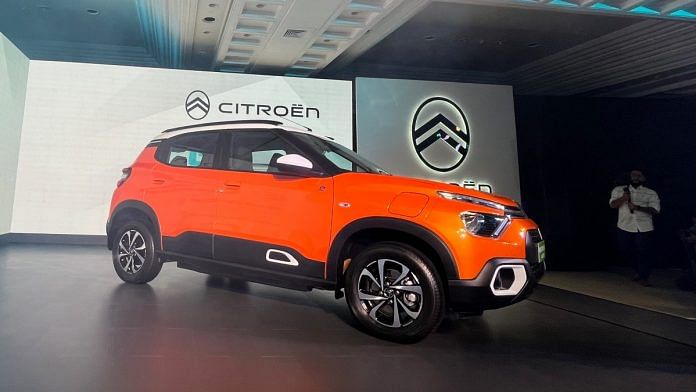A few months ago, I had mentioned some ‘unkind’ words about the Citroën C3 hatchback. Nothing personal, all part of my job when reviewing a car. But on driving the car’s electric version, I was pleasantly surprised. Why? Because the French carmaker has now addressed some of the key concerns present in the petrol version, particularly the absence of a prismatic night setting on the inside rear-view mirror and a reverse camera.
Did I mention that this was an electric car? Yeah, that is why I found myself on a test-track outside Chennai where German component maker ZF tests braking systems. So what are the headline numbers for the imaginatively named ëC3? You get a 29.2kWh battery that runs on Lithium Ferro-Phosphate (LFP) chemistry that the carmaker says is good enough for a 320km range with a top speed of 107kmph. Interestingly, the battery pack is air-cooled, a fact that raised quite a few heckles on my Twitter when I posted this info out.
Roland Bouchara, CEO, Stellantis India (the holding company of Citroën), said that the ëC3 has been extensively tested in Indian summer conditions. It was also mentioned that LFP cells are far more thermally stable than Lithium-NMC (Nickel-Manganese-Cobalt) cells. This is important in light of the spate of electric two-wheelers with NMC cells catching fire last year.
Tata Motors, which also uses LFP cell battery packs on their electric cars, against which the ëC3 will compete, do have active liquid-cooling systems. One suspects that the lower power output of the Citroën coupled with a small motor and restricted top speed (although every electric vehicle has a restricted top speed to manage power consumption and temperatures) is the reason why Citroën has done what they have done. With extensive testing in Indian summer and monsoon conditions, I have no reason to believe that there will be any issues.
Also read: Toyota, Hyundai, BYD—leading carmakers add to Auto Expo 2023’s sustainability theme
The drive
Now, how is this car to drive? Honestly, it does what it says on the cover – it is a small urban hatchback and for that purpose, it does its job. Because this is an urban runabout, it will not really be used on longer drives. It accelerates as well as can be expected of a hatchback, and since the speed maxes out very soon, you realise this isn’t the one to drive fast. Cornering and ride quality were good but because we were on a high-grip and very smooth private road, that became easy to achieve. One doesn’t know how it will do when subjected to the construction sites of Andheri, for example.
And truth be told, while the car is silent, the low-rolling resistance tyres from Ceat aren’t. With an expected real-world range of around 225-250kms and the extremely low-running costs of an electric car, it would work very well for those who drive long distances in the NCR every day. And thanks to an ace up its sleeve, with commercial and fleet operators as well.
Also read: India is moving closer to its ethanol blending goal. But the ‘green switch’ is far from easy
Charging the ëC3
The company says that while the battery pack is air-cooled, the battery management system on the ëC3 allows it to be fast-charged by Direct Current (DC) chargers in every cycle without damaging the battery. On most electric cars, especially the ones that this car will compete against, companies recommend at least one slow-charging cycle from an Alternating Current (AC) charger for every 2-3 fast cycles. Given that the ëC3 and its main rival, the Tata Tiago.EV, can only charge at 3.2kW when on AC charging, a slow-charge cycle takes up 8-10 hours. The ëC3 can use a 30kW DC fast-charger to almost fully charge itself in about 57 minutes.
While this is unlikely to make a difference to private car buyers who can charge overnight anyway, Saurabh Vatsa, Brand Head, Citroën India believes that the car will be an attractive proposition for fleet operators for this very reason. “Minimal downtime for charging, which means the car can be productive for longer, which will allow operators to take full advantage of the operating cost efficiencies of electric cars compared to internal combustion engine vehicles.” Vatsa added that during development of the ëC3, the engineers were in touch with large fleet operators such as electric cab companies and corporate transport fleets. “Many companies, especially multinationals have fixed timelines to reduce their carbon footprint, particularly on transportation,” said Vatsa.
To make this car even more appealing for commercial and fleet operators, Citroën has opened the interface of their infotainment system. Operators can add their own applications for vehicle monitoring. Or build their driver application into the car instead of making the driver rely on their smartphone.
But is it sensible for a carmaker to ripen up to the ‘yellow plate’ market at product launch? Citroën believes it has an opening. And being a tiny player in the market currently, selling less than a thousand cars per month, the ëC3 could be the (rather silent) battering ram the carmaker needs to break open the market in India.
Bouchara is also hoping that success with the ëC3 in India might teach the Franco-Italian-American automotive giant a trick or two about low-cost engineering and allow them to send this car from Chennai to markets well beyond India. After all it will be, by far and away, the cheapest electric vehicle in Stellantis’ line-up globally (Citroën, Chrysler, DS, Fiat, Jeep, Peugeot).
@kushanmitra is an automotive journalist based in New Delhi. He was one of the jury members on the ICOTY panel. Views are personal.
(Edited by Anurag Chaubey)



